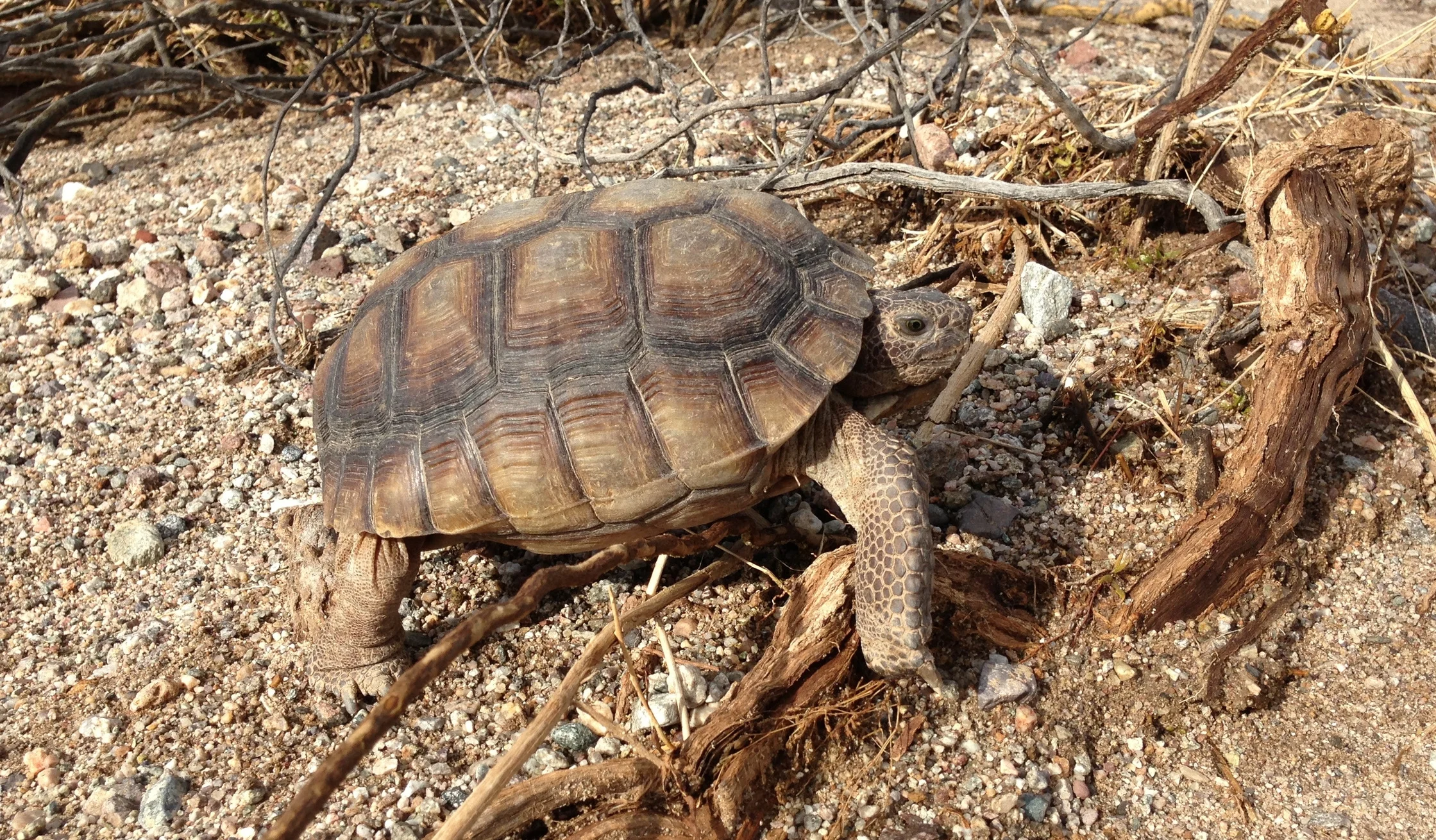Mojave Desert Tortoise (Gopherus agassizii)
The Mojave desert tortoise, a distinct species from the Sonoran desert tortoise (Gopherus morafkai), is an icon of the California Mojave Desert. Adults can reach up to 15 inches in carapace (shell) length and 4-6 inches in height. In late winter to early spring, they emerge from their wintering burrows, remaining active until the fall. Desert tortoise activity decreases during the high heat of summer; however, they often emerge after monsoon rain storms to rehydrate and forage. They are highly adapted to the brutal desert environment, escaping temperature extremes by spending most of their lives underground in their moon-shaped burrows.
Listing Status
Federally Threatened (USFWS)
CA State Threatened (CDFW)
Suitable Habitat
The desert tortoise occurs within a variety of habitats from creosote (Larrea tridentata) dominated bush scrub to blackbrush (Cologne ramosissima) scrub and juniper (Juniperus occidentalis) woodland transition zones. Within the majority of the Mojave Desert, the species occurs on gentle slopes with sandy-gravel soils and sparsely distributed low-lying vegetation. They utilize caliche, a hard subsoil calcium carbonate layer, caves for shelter and overwintering. Burrow soil composition and drainage capabilities are important as the desert tortoise requires friable substrate for easy burrowing but firm enough as to not collapse. Habitat must be able to support a high diversity of perennial plants and production of annual vegetation. Desert tortoise forage on perennial grasses, woody shrubs, cacti, annual wildflowers, and non-native annuals.
Breeding
Upon emerging from winter, males immediately start combating with one another, attempting to flip their opponent by using their gular shield as a lever. Courtship and mating occurs in spring and early summer. Females lay eggs at the beginning of the summer monsoon season, during June and July. Females are able to store sperm, therefore clutches laid in the summer are fertilized from the previous summer's copulations (Averill-Murray et al. 2002). Females often guard their nest sites for most of the summer, protecting their eggs from predators. Eggs typically hatch approximately 3 months after being laid, in September and October; however, some eggs overwinter and hatch in the spring. Hatchlings measure about 2 inches in length with extremely soft shells, making them very susceptible to predation. Tortoise sex determination is temperature-dependent where higher temperatures produce females. Females may lay up to 3 clutches in a single breeding season.
Survey Requirements
Once it is determined that a survey is required based on the site assessment key found in the 2010 USFWS revised protocol, the purpose of the survey is to: determine presence/absence, estimate abundance, and identify tortoise distribution within the action area in support of developing subsequent minimization/avoidance measures. The action area is defined as the total area where desert tortoise may be directly and/or indirectly adversely affected by the proposed activities. For example, this includes the proposed impact area as well as existing access roads that may be utilized during proposed construction activities. Survey sheets with survey results are to be submitted to USFWS within 30 days of survey completion.
If the action area is large or if the project could affect more than 2 tortoises, surveys are to be conducted during April-May or September-October when ambient temperatures are less than 104 F. If the goal of the survey is to only determine presence/absence, surveys may be conducted outside of the above mentioned timeframe pending USFWS approval. Surveys are conducted by walking 30 foot wide belt transects covering 100% of the action area. Probabilistic sampling may be more appropriate for large action areas.
Conservation Status
The Mojave Desert Tortoise was federally listed on August 20, 1980. Approximately 6,000,000 acres of critical habitat was designated by the USFWS in 1994 that includes portions of the Mojave and Colorado deserts.
Documents/Links
USFWS Pre-project field survey protocol (2010)
USFWS Authorized Biologist and Monitor Responsibilities and Qualifications (2010)
Desert Tortoise Recovery Office
USFWS Desert Tortoise (Mojave Population) Field Manual (2009)
USFWS Revised Recovery Plan for the Mojave Population of the Desert Tortoise (2011)
References
Averill-Murray, R., et al. 2002. Activity and Behavior of the Sonoran Desert Tortoise in Arizona. Pp. 135-158 in T Van Devender, ed. The Sonoran Desert Tortoise. Tucson: The University of Arizona Press.
Edwards, T., E. Stitt, C. Schwalbe, D. Swann. 2004. Gopherus agassizii (Desert tortoise). Movement. Herpetological Review, 35(4): 381-382.
U.S. Fish and Wildlife Service. 2009. Desert Tortoise (Mojave Population) Field Manual: (Gopherus agassizii). Region 8, Sacramento, California.
U.S. Fish and Wildlife Service. 2011. Revised recovery plan for the Mojave population of the desert tortoise (Gopherus agassizii). U.S. Fish and Wildlife Service, Pacific Southwest Region, Sacramento, California. 222 pp.






